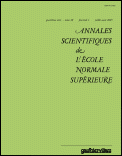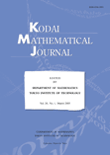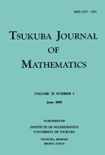
Journal of Geometry
Scope & Guideline
Pioneering Research in Geometry and Topology
Introduction
Aims and Scopes
- Differential Geometry:
Exploration of the properties and applications of differentiable manifolds, including studies on curvature, geodesics, and solitons. - Riemannian and Pseudo-Riemannian Geometry:
Investigation into Riemannian metrics, curvature, and geometric structures in both Riemannian and pseudo-Riemannian settings, including applications in general relativity. - Geometric Analysis:
Analysis of various geometric structures through differential equations and variational methods, contributing to the understanding of solitons and curvature flows. - Algebraic Geometry:
Research into the intersection of algebra and geometry, focusing on geometric objects defined by polynomial equations, including classifications and properties of manifolds. - Applications of Geometry in Physics:
Application of geometric concepts to physical theories, particularly in the context of Einstein's theory of relativity and other theoretical physics frameworks. - Topological and Geometric Structures:
Examination of topological properties and their relation to geometric concepts, including studies on manifolds, surfaces, and their invariants.
Trending and Emerging
- Solitons and Geometric Flows:
An increasing number of papers focus on solitons, particularly in Riemannian and pseudo-Riemannian contexts, showcasing their significance in both theoretical and applied mathematics. - Statistical Geometry:
The integration of statistical methods with geometric analysis has emerged as a prominent theme, reflecting the growing interest in probabilistic approaches to geometric problems. - CR Geometry and Complex Structures:
Research in CR geometry is on the rise, indicating a growing interest in complex structures and their applications in higher-dimensional geometry. - Geometric Analysis on Manifolds:
A trend towards the application of geometric analysis techniques, including variational methods and curvature analysis, demonstrates the journal's focus on advanced mathematical frameworks. - Applications to Theoretical Physics:
There is a notable increase in publications that bridge geometry with theoretical physics, particularly in the context of general relativity and quantum theories.
Declining or Waning
- Classical Geometric Constructions:
Research related to classical geometric constructions and properties has seen a decrease, possibly due to a shift towards more abstract and higher-dimensional studies. - Elementary Geometry:
Papers focused on elementary and foundational aspects of geometry are becoming less common, indicating a move towards more complex and specialized topics. - Geometric Transformations in Low Dimensions:
The exploration of geometric transformations specifically in two or three dimensions appears to be waning, as the journal's focus shifts to higher-dimensional and more abstract geometrical theories. - Historical Studies in Geometry:
The publication of papers that focus on historical perspectives or biographical notes on geometric figures has decreased, suggesting a trend towards more contemporary and applied geometric research. - Basic Topological Concepts:
There has been a decline in papers addressing basic topological concepts, indicating a potential shift towards more specialized and advanced topics in topology.
Similar Journals

TRANSFORMATION GROUPS
Transforming Mathematical Insights for Tomorrow's ScholarsTRANSFORMATION GROUPS, published by Springer Birkhäuser, is a leading academic journal specializing in the fields of algebra, geometry, and topology. With its ISSN 1083-4362 and E-ISSN 1531-586X, the journal has established itself as an essential resource for researchers and academicians, achieving a remarkable Impact Factor and ranking in prestigious categories: Q1 in Algebra and Number Theory and Q2 in Geometry and Topology as of 2023. Over its history from 1997 to 2024, TRANSFORMATION GROUPS has delivered cutting-edge research and innovative insights, currently holding Scopus rankings of #40/119 in Algebra and Number Theory and #38/106 in Geometry and Topology. This journal caters to those seeking to enhance their understanding of mathematical transformations and their applications, making it a vital platform for scholarly discourse within the mathematical community.

ANNALES DE L INSTITUT FOURIER
Pioneering Research in Algebra and GeometryANNALES DE L INSTITUT FOURIER is a premier academic journal published by ANNALES INST FOURIER, specializing in the fields of Algebra and Number Theory as well as Geometry and Topology. Since its establishment, the journal has garnered a distinguished reputation, evidenced by its Q1 quartile ranking in the 2023 category assessments and its Scopus Rank of #37 out of 119 in Algebra and Number Theory, and #34 out of 106 in Geometry and Topology, placing it within the top percentile of its field. The journal serves as a vital platform for disseminating groundbreaking research and innovative methodologies, catering to a global audience of researchers, professionals, and students. With a commitment to the advancement of mathematical sciences, ANNALES DE L INSTITUT FOURIER invites contributions that push the boundaries of knowledge and foster collaboration across disciplines. Although it does not offer open access, the rigorous peer-review process ensures that published papers meet the highest academic standards, making it a critical resource for anyone engaged in advanced mathematical research.

JOURNAL OF GEOMETRY AND PHYSICS
Bridging Dimensions: Where Geometry Meets PhysicsThe JOURNAL OF GEOMETRY AND PHYSICS is a distinguished peer-reviewed journal published by Elsevier, dedicated to fostering the exploration and dissemination of research at the intersection of geometry and physics. Established in 1984, this journal covers a broad range of topics, including the theoretical aspects of geometry, topology, and mathematical physics, making it an essential resource for researchers and practitioners in these fields. With an impressive Q2 ranking in various categories, including Geometry and Topology, Mathematical Physics, and General Physics and Astronomy, the journal ranks among the top 25% of its peers, reflecting its significant impact in advancing relevant discourse. Although currently not offered as an open-access publication, it maintains a strong readership due to its contribution to high-quality scholarly articles and critical reviews. The journal’s commitment to stimulating innovative research continues to solidify its reputation as a pivotal platform for exchanging ideas and fostering collaboration within the scientific community.

Pure and Applied Mathematics Quarterly
Exploring the Depths of Theoretical and Practical MathematicsPure and Applied Mathematics Quarterly is a prestigious journal published by INT PRESS BOSTON, INC, focusing on the diverse and evolving field of mathematics. Since its inception in 2007, this journal has grown significantly, currently holding a Q1 ranking in the Mathematics (Miscellaneous) category for 2023, positioning it among the leading publications in the discipline. With a commitment to publishing high-quality research, Pure and Applied Mathematics Quarterly fosters innovation and dialogue within the mathematical community by providing a platform for theoretical advancements and practical applications. The journal remains accessible to researchers and professionals through its ISSN 1558-8599 and E-ISSN 1558-8602, although it does not currently offer open access. As a vital resource for mathematicians, educators, and students, this journal endeavors to expand the frontiers of mathematical knowledge and contribute to the academic dialogue surrounding this fundamental science.

ANNALES SCIENTIFIQUES DE L ECOLE NORMALE SUPERIEURE
Discover Innovative Insights in MathematicsANNALES SCIENTIFIQUES DE L ECOLE NORMALE SUPERIEURE is a distinguished journal published by the Société Mathématique de France, dedicated to advancing the field of mathematics through high-quality research articles. With a robust impact factor and categorized as Q1 in Mathematics (Miscellaneous) as of 2023, this journal ranks in the top 16% of mathematics publications, showcasing its importance and influence in the discipline. Available in both print (ISSN: 0012-9593) and electronic formats (E-ISSN: 1873-2151), ANNALES SCIENTIFIQUES serves as a central hub for innovative mathematical theories and methodologies, appealing to a diverse audience of researchers, professionals, and students alike. The journal publishes research that spans various domains within mathematics, fostering a collaborative environment for idea exchange. As it converges from 1997 to 2024, it continues to shape the mathematical landscape, providing essential insights and developments within the global academic community. Located in Paris, France, the journal invites contributions that push boundaries and advance the understanding of complex mathematical concepts.

Kodai Mathematical Journal
Bridging Tradition and Novelty in MathematicsKodai Mathematical Journal is a distinguished publication dedicated to advancing the field of mathematics, particularly in miscellaneous areas. Established in 1949, this esteemed journal has been a reputable source for researchers and practitioners who seek to contribute to the rich landscape of mathematical knowledge. Published by KINOKUNIYA CO LTD, the journal is based in the academic environment of Tokyo Institute of Technology and serves a global audience with rigorous and insightful research articles. Despite its current Q3 quartile ranking in the Scopus Mathematics category, which reflects its niche but impactful contributions, the journal is poised for growth; the convergence of traditional and novel mathematical techniques promises to enhance its relevance further. Researchers, professionals, and students are encouraged to engage with the rich content of the journal, aimed at fostering collaboration and nurturing innovation in the mathematical community. While currently not available as Open Access, Kodai Mathematical Journal remains a critical resource for those passionate about mathematics and its applications.

Symmetry Integrability and Geometry-Methods and Applications
Illuminating the Path of Analysis, Geometry, and TopologySymmetry Integrability and Geometry-Methods and Applications is a prominent open-access journal published by the NATIONAL ACADEMY OF SCIENCES OF UKRAINE, INSTITUTE OF MATHEMATICS, dedicated to advancing research in the fields of Analysis, Geometry and Topology, and Mathematical Physics. Since its inception in 2005, the journal has provided an esteemed platform for scholars from around the globe to share their innovative findings and methodologies, contributing to our understanding of complex mathematical concepts. With an impressive Q2 ranking in all three mathematical categories as per the 2023 Scopus rankings, the journal positions itself as a key resource for researchers seeking high-quality, peer-reviewed content. As a fully open-access publication, it ensures that research is readily available to a wide audience, fostering collaboration and knowledge exchange in the mathematical sciences.

Tsukuba Journal of Mathematics
Bridging Knowledge Gaps with Cutting-Edge ResearchTsukuba Journal of Mathematics is a distinguished publication dedicated to advancing the field of mathematics through the dissemination of innovative research and comprehensive studies. Published by the University of Tsukuba, Department of Mathematics, this journal serves as a vital platform for mathematicians, researchers, and students to engage with cutting-edge mathematical theories and methodologies. Although currently not available as an open-access journal, it maintains a strong academic presence, contributing significantly to the global mathematical landscape. The journal invites submissions across various branches of mathematics, aiming to foster scholarly communication and collaboration. The ISSN 0387-4982 and the E-ISSN 2423-821X further establish its credibility and accessibility among the academic community, supporting its critical objective of facilitating high-quality research output. Situated in Tsukuba, Japan, a hub for scientific research and development, the Tsukuba Journal of Mathematics is committed to bridging gaps in mathematical knowledge and encouraging exploration of novel ideas.

JOURNAL OF DIFFERENTIAL GEOMETRY
Charting new territories in the world of mathematics.JOURNAL OF DIFFERENTIAL GEOMETRY, a premier publication by INT PRESS BOSTON, INC, has established itself as a leading forum for the dissemination of high-quality research in the fields of differential geometry, algebra, and analysis. With an impressive history that spans from 1967 to 2024, this journal is recognized for its rigorous peer-reviewed articles, contributing significantly to the advancement of mathematical theories and innovative approaches. Notably, the journal boasts a Q1 ranking in key categories such as Algebra and Number Theory, Geometry and Topology, and Analysis, reflecting its pivotal role within the mathematics community. Its Scopus rankings reinforce its reputation, placing it among the top-tier journals in its respective fields, with a 97th percentile ranking in Algebra and Number Theory, further emphasizing its influence. While the journal does not offer Open Access options, it remains a critical resource for researchers, professionals, and students aiming to stay at the forefront of developments in differential geometry and related domains. Engage with groundbreaking research and explore new methodologies that are shaping the future of mathematics.

Journal of Dynamical Systems and Geometric Theories
Unraveling Complexities in Dynamical SystemsJournal of Dynamical Systems and Geometric Theories, published by TARU Publications, is a prominent platform dedicated to advancing knowledge in the fields of dynamical systems and geometric theories. With an ISSN of 1726-037X and an E-ISSN of 2169-0057, this journal serves as a vital resource for researchers, professionals, and students who are keen on exploring the complexities of mathematical models and their applications in various scientific disciplines. Though currently listed as non-open access, the journal provides robust, peer-reviewed content that is essential for fostering innovative research and development. Situated in New Delhi, India, the Journal of Dynamical Systems and Geometric Theories is committed to disseminating high-quality scholarly articles that address both theoretical and practical issues related to dynamical systems, enhancing understanding and stimulating further academic discourse. To learn more about submission guidelines and access options, please visit the journal’s official webpage.